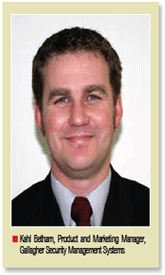Staging a Defense With Perimeter Security Solutions
Designing a perimeter solution no longer means stringing barbed wire and erecting high fences. The perimeter solutions of today are more sophisticated, with sensors accurately detecting intruders, while ignoring false alarms from wind or small animals. A&S talked to several vendors about their products and how they fit into a comprehensive solution.
Perimeter security is one of the most visible categories of securitywith bollards, sensors and barriersand one of the most effective at preventing direct attacks. It integrates a wide range of physical barriers and intrusion detectors, ensuring only authorized individuals have access to restricted areas. A look at perimeter products presents an overview of what solutions are available on the market and where they are used.
Laying the Foundation
Evaluating possible threats and vulnerable areas is crucial for an effective perimeter solution. Fiber SenSys, a subsidiary of CompuDyne, makes fiber-optic sensors for perimeter solutions. The company focuses on developing high-performance systems suitable for high security applications.

"A perimeter security program typically contains up to four elements: detection, assessment, delay, and response," said Michael Montgomery, Fiber SenSys Business Development Manager for Europe. "The intrusion detection system (IDS) provides the first element, detection, and often facilitates the assessment element. A perimeter intrusion sensor system is generally implemented as an input to a per imeter security management system. The IDS system generates an intrusion alarm signal, usually in the form of a zone alarm, indicating the relative location of an intrusion attempt. Most commonly, and especially in higher security applications, the intrusion sensor signal is used as a trigger to orient a CCTV camera on the zone of intrusion, and/or automatically switch the camera image to a monitor in the security control center. This facilitates the ability to assess both the validity of the signal as an actual intrusion attempt, and to determine the most appropriate response method."
Integrating the range of systems intrusion detection, video surveillance and often access controlis part of the challenge perimeter vendors face today. The reason for all this hardware is to overcome the failings of security guards, who cannot be expected to keep an eye on all events in the perimeter of an area. Amphitech Systems offers a radar solution to counteract some problems in traditional surveillance.
"With traditional methods, be they constant human surveillance (subject to human error, inattention and poor visibility constraints) or fence sensors of various kinds, the first two elements of Detect and Delay occur so late as to be squandered giving the intruder the advantage of surprise and time," said Alan Browne, Public Affairs representative for Amphitech Systems. "And once inside the perimeter, the intruder may not be adequately covered. Full control of the situation can only be attained by managing all four phases of perimeter defense. So a sensor is needed that sees well beyond the physical perimeter and that can track intruders within the perimeter fence as well."
Designing For Different Places
Knowing the lay of the land plays an important role in deciding what functions are appropriate for different installations. Along with establishing the basic groundwork, understanding a location's unique attributes helps deliver a targeted defense to effectively serve user needs. Adjusting the level of security for a factory and a nuclear silo makes an appropriate perimeter solution more useful than an overly sensitive or unresponsive one.

Kahl Betham, Product and Marketing Manager, Gallagher Security Management Systems, said, "If your environment is industrial or military, the fence line can be designed to create an imposing presence around your property conveying that you're serious about site security and deterring attack. For a corporate site, a PowerFence solution can be incorporated subtly and unobtrusively to convey a professional, sophisticated and customerfriendly image. For sites with specific architectural or heritage elements, such as existing fence lines, PowerFence systems can be integrated to ensure the protected feature remains untouched."
Sometimes a portable solution is preferred over a permanent one, such as for military bases and camps. For Delta Scientific, a maker of sensors, bollards and barriers, different barriers suit specific needs. "If the military base is to be permanent, the difference between guarding the perimeter is quite similar," said David Dickinson, Senior Vice President. "By their very nature, terrorist attacks are unpredictable and predicated on surprise. Staying one step ahead by identifying vulnerable areas, and securing them, is critical to staving off vehicular attacks. Terrorists typically don't go where they see barricades, so placing them wherever possible attacks can happen reduces security risks dramatically."

Some locations do not permit use of permanent barriers, such as when the sites are too shallow to dig barrier foundations, which make portable solutions preferable. "The differentiating aspect of military bases is that they can move," Dickinson said. "That means being able to deploy security equipment in tough conditions, at a moment's notice. Fortunately, such equipment now exists in the form of portable, towable, temporary barriers. These barriers can be deployed quickly and effectively, even in places where it's impossible to excavate for a permanent foundation, such as the streets of Paris."
Military users find portable perimeter systems secure yet flexible, including Jerry Edwards, U.S. Army R&D Deputy Product Manager, Physical Security Equipment. "This type of barrier provides a new element in force protection both in the U.S. and overseas," he said in a Delta Scientific press release. "It's especially relevant for threat conditions in the military, where there are a series of force protection issues. Having an increased level of security, when moving from locale to locale, is a big advantage."
Zooming in on Possible Threats
Identifying who would want to breach a location's defenses helps define what sensors or barriers would be most appropriate for that location's needs. A used car lot and a nuclear power plant would be broken into for different purposes, requiring different levels of protection.
Southwest Microwave produces a range of microwave frequency sensors to detect changes, which can be adjusted for sensitivity and range. Developing a profile of possible intruders helps determine what type of security is needed, said Tom Gibbons of Southwest Microwave's Technical Sales Group. "Understanding what the user is trying to protect and who they are protecting it from will facilitate responsible specification of equipment, configuration and zone length."
For example, a low security application concerned about vandalism or possible liability lawsuits would want to prevent trespassers from accessing the site and getting hurt. "Here the threat level is low," he said. "The user would be looking to detect someone relatively harmless, without the knowledge or experience to try to defeat the security systema target simply walking or running onto the site after scaling a fence or wall."
To effectively detect walking, running or crawling human intruders, Gibbons suggested a short-range (30 meters or 100 feet) detection solution with wide-angle view is appropriate for monitoring gate areas. An increased range (107 meters to 183 meters or 350 feet to 600 feet) is better suited for complete perimeter protection.
"PowerFence systems are complete end-to-end perimeter security solutions," Betham said. "To detect climbing, its products include anti-climbing insulators. The insulators are designed with a weak portion that collapses when someone tries to climb over a barrier, thereby triggering an alarm."
For sites facing higher security risks, such as a commercial or industrial site, Gibbons suggested a solution designed to prevent theft. "This scenario has a higher threat level because assets are at stake," he said. "We would generally see a more experienced intruder with some degree of knowledge about detection technology. This individual would go to greater lengths to defeat the facility's detection equipment, perhaps by attempting to crawl under the signal."
Giving would-be intruders a rude shock can be considered as an option for perimeter security. Electric-pulse products offered by PowerFence, which can be "nearly doubled" to 14 kV and 4.6 joules in a dual-pulse product, deliver nonlethalbut effectiveshocks to deter intruders. For the higher-energy product, the pulses are strong enough to penetrate thicker clothing, with the additional pulses allowing for interleaved alarmeddeterrent zone wire or twice the detection. If a zone comes under attack, the controller ensures the remaining zones are unaffected.
If jolting unwelcome guests would not be the user's preferred method of keeping them out, placing sensors underground provides a discreet alternative. Southwest Microwave offers a buried cable sensor that detects "walking, running, jumping or crawling intruders, while also pinpointing their location to within three meters (10 feet)," according to a prepared statement.

"You can fine-tune the sensitivity based on each site's particular needs," said Steve O'Brien, Southwest Microwave Product Engineer. "To configure the system, you simply do a calibration walk and set a sensitivity threshold based on the site's profile. When a target enters the detection field, the receiver cable picks up the altered signal in the disturbed field and transmits it to the processor. Then, the processor analyzes the phase and amplitude of the altered signal and compares this with the calibrated threshold." This allows for flexibility, customized to the level of security required by users.
A hidden detection system happens to be easy on the eyes as well. "The buried cables of the MicroTrack system provide covert, terrain-following detection," said Southwest Microwave in a prepared statement. "Neither potential intruders nor innocent passers-by will know that a perimeter security system is in place, making the MicroTrack system less vulnerable to defeat and more aesthetically pleasing." As the solution is designed for different types of terrain, the solution can be implemented in diverse locations.
Preventing Direct Vehicular Attacks
Less subtle attacks, such as deliberately crashing a vehicle into a barrier, become a serious consideration when designing perimeter solutions.
For Delta Scientific, preventing vehicular crashes into protected areas makes up a key part of its evaluation process. "When evaluating the security risk for a given facility, particular attention must be focused on the weights and velocities of vehicles that would be used to attempt penetration into sensitive areas," Dickinson said. "A vehicle moving towards a barricade has a certain kinetic energy, which is the major measure of how much 'hitting power' it possesses. Mathematically, kinetic energy is derived from the vehicle velocity and its weight (mass). On impact, some of this energy is converted to heat, sound and permanent deformation of the vehicle. The barricade must absorb the remainder of this energy if the vehicle is to be stopped."
As speed is needed for the most destructive impact, reducing it by placing barriers strategically is important. "Because of the relationship of velocity to the total kinetic energy possessed by the vehicle, every effort must be made by the security engineer to force a vehicle to slow down before it reaches the barricade," Dickinson said. "The most frequently used technique is to require a sharp turn immediately in front of the barrier. When vehicle speed is reduced by 50 percent, the 'hitting power' is reduced by four times. If the speed is reduced by two-thirds, the force of impact will be reduced by nine times. Upon designing a way to slow down vehicle approach, precautions should also be taken that the attacking car cannot make a 'corner cutting shot' at a barricade. Often, only a light post defines a turning point and a speeding car can take it out and not even hesitate. Knolls and other impediments should be considered. Failing to understand this and not using the proper equipment to counter the threat may lead to a false sense of security."
To track vehicles before they get in range to cause damage, Delta Scientific uses radar to detect possible threats. "Continuous Doppler Radar picks up instantaneous changes in velocity and addresses the threat scenario in which an inbound vehicle approaches at normal speeds and then accelerates to commence the attack," Dickinson said. "It will also warn if a hidden vehicle suddenly passes a larger vehicle and attempts an attack. Once alerted, the guards can take action, including raising the Delta barricade systems. ... if a vehicle is going too fast, defensive action must be initiated."
The Integration Game
Tying together video surveillance, intrusion sensors and barriers requires a high level of product knowledge and familiarity with specific locations. Some perimeter vendors specialize in one product sector, such as barricades. Others tackle all of a perimeter solution, from sensors to management software.
The majority of Fiber SenSys customers are security systems integrators, Montgomery said. "Communications with the integration industry has illustrated that there is an increasing tendency to interlink the various elements of a security systemintrusion alarm systems, CCTV systems, and access control, using network technology. More and more, security managers of major facilities want interconnections that can be managed and accessed via TCP/IP networks. Usually these are secure, 'closed' networks, but there is also substantial interest in open-access networks, of course with substantial firewall security to prevent access to the security system by unauthorized parties."
PowerFence systems allow end users similar flexibility, as the system can be installed as a stand-alone system or directly interfaced or integrated with intruder alarm and access control systems. For example, the Cardax FT system can be used for arming and disarming zones, alarm monitoring and signaling. Cardax FT is a fully featured integrated security management system also developed and manufactured by Gallagher Security Management Systems. It can support business efficiencies through interfacing with building management systems, such as air conditioning and lighting. Where access control is configured by certified Cardax FT channel partners, cardholder data can be shared with third-party people management systems such as HR (human resources) systems.
Magal Security Systems supports total perimeter security, with an end-to-end range of products. It has installed more than 10,000 kilometers (about 6,200 miles) of its systems worldwide, according to its Web site, giving the company a 40 percent market share of the perimeter security market. The company's offerings include a variety of sensors, integrated CCTV products and barriers. Magal products are used in airports, borders and nuclear power plants. "By combining the various technologies of the Group, we are able to design and installand have installedmulti-disciplinarian systems combining different technologies and providing turnkey solutions for complex security problems," the company said on its Web site.
Canceling False Alarms
While it may be useful to have sensitive alarms in high-security areas, added sensitivity also adds the possibility of false alarms. Eliminating false alarms, which cause frustration and lost time from patrolling, are a challenge. As false alarms also hurt the bottom line, perimeter vendors have taken steps to reduce them.
Southwest Microwave has adjustable sensitivity for its buried sensor to reduce the frequency of false alarms. "The advanced MicroTrack system uses the pre-configured threshold information to detect legitimate targets and ignore harmless disturbances such as small animals crossing the detection field," it said in a prepared statement. "The system's high signal-to-noise ratio and precise target location offers excellent probability of detection and a negligible nuisance alarm rate."
Frequent field testing of Southwest Microwave's system put it through repeated tests of its sensitivity and false alarm rate worldwide. "We performed thousands of hours of field research, application studies and testing over the last several years, as we do with all of our intrusion detection sensors," said Mike Tutor, Product Engineer. "We were impressed with how repeatable and consistent target detection and location have been during our testing phase."

Crawling detection, needed to catch intruders, can also result in numerous false alarms. Zone length, along with ensuring overlapping areas, is a factor when assessing whether an alarm is a legitimate one. A video surveillance camera to visually verify if a disturbance is in fact a true threat is also important. "When camera assessment is involved, maintaining zone lengththe head to head detection areaat a maximum of 100 meters is optimal for clear visibility of the target," Gibbons said.
Increased sensitivity of a sensor requires more robust sensor signal processing in the sensor processing unit. "The higher level of sensitivity of a fiber-optic sensor system mandates a high level of signal analysis to provide reliable detection of even stealthy intrusion attempts while eliminating alarms from non-threatening noise sources," said Montgomery of Fiber SenSys. Its system processes sensor signals in real time, in three stages.
First, it conducts wind analysis. "The most common source for nuisance alarms in fence-mounted cable-based intrusion sensor systems is wind, and (related) rain," he said. "Instead of merely adjusting the sensitivity to suppress wind-induced signals, the APU (alarm processing unit) detects and recognizes cable disturbances that are the result of weather-induced motion and vibration. The sensor signal is then compensated so that these disturbances do not generate alarms."
Second, event analysis compares sensor signals with defined parameters for each zone. "During system installation, each zone is 'calibrated' to match the response of the sensor to the physical performance of the fence or other barrier," Montgomery said. "Variables like signal amplification, sensitivity, frequency response are adjusted according to the way the fence responds to intrusion attempts, as well as to non-threatening disturbances like wind."
Last, alarm analysis determines how the system will respond to the signals. "Many things can cause a fence to react with a burst of noise, but an actual intrusion attempt will cause a series of disturbances within a given time frame," Montgomery said. "Alarm processing sets the APU (alarm processing unit) to respond with an alarm output only when a series of disturbances meet the defined criteria, which again are adjusted to match the fence's characteristics as well as the level of security required for a facility."
If power stops or is deliberately cut, backup power systems keep the perimeter security systems running, designed into nearly every vendor's solution. As power loss can trigger alarms, preventing interruption of power allows perimeter systems to operate effectively.
Fortifying Boundaries
As technology has improved, perimeter security has also grown to be more sophisticated. A secure location no longer needs to resemble a jail to provide adequate protection of people and assets within the boundaries. Even barriers can be discreet, yet effectively detect for intruders and eliminate nonevents in an outdoor situation, like wind or small animals. With the rise in integrated products, human operators can use one platform to monitor multiple systems, allowing for convenience and simplicity to detect threats. Outdoor perimeter security is a high-profile and crucial part of a complete security system, with integration developments worth watching.

